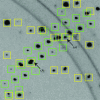New Python-based methods for data processing
- PMID: 23793153
- PMCID: PMC3689530
- DOI: 10.1107/S0907444913000863
New Python-based methods for data processing
Abstract
Current pixel-array detectors produce diffraction images at extreme data rates (of up to 2 TB h(-1)) that make severe demands on computational resources. New multiprocessing frameworks are required to achieve rapid data analysis, as it is important to be able to inspect the data quickly in order to guide the experiment in real time. By utilizing readily available web-serving tools that interact with the Python scripting language, it was possible to implement a high-throughput Bragg-spot analyzer (cctbx.spotfinder) that is presently in use at numerous synchrotron-radiation beamlines. Similarly, Python interoperability enabled the production of a new data-reduction package (cctbx.xfel) for serial femtosecond crystallography experiments at the Linac Coherent Light Source (LCLS). Future data-reduction efforts will need to focus on specialized problems such as the treatment of diffraction spots on interleaved lattices arising from multi-crystal specimens. In these challenging cases, accurate modeling of close-lying Bragg spots could benefit from the high-performance computing capabilities of graphics-processing units.
Keywords: cctbx; data processing; multiprocessing; reusable code.
Figures






References
-
- Abrahams, D. & Grosse-Kunstleve, R. W. (2003). C/C++ Users J. 21, 29–36.
-
- Adams, P. D. et al. (2010). Acta Cryst. D66, 213–221. - PubMed
-
- Arya, S., Mount, D. M., Netanyahu, N. S., Silverman, R. & Wu, A. Y. (1998). J. Assoc. Comput. Mach. 45, 891–923.
Publication types
MeSH terms
Substances
Grants and funding
LinkOut - more resources
Full Text Sources
Other Literature Sources

